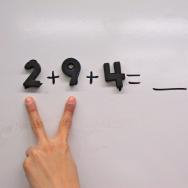There has been much speculation about whether lower female participation rates in STEM fields can be traced to an innate male superiority in math and science. But a new University of Chicago study wanted to test whether boys and girls actually show different mathematical abilities at their earliest developmental stages.
UChicago postdoctoral researcher Alyssa Kersey recently co-authored research in the Nature journal Science of Learning that showed the ability to understand numbers is not innately different in boys and girls. Young boys and girls share similar abilities, according to the study, and any differences that show up later are likely learned.
“Across all stages of numerical development, analyses consistently revealed that boys and girls do not differ in early quantitative and mathematical ability,” Kersey and her co-authors wrote. “These findings indicate that boys and girls are equally equipped to reason about mathematics during early childhood.”
Kersey and her colleagues point out in their paper that gender differences in math and science have been the focus of research for many years, but findings have been inconsistent. Kersey said she relied on her own dissertation—research that focused on how the developing brain represents the idea of number.
“Because of this focus on early-childhood mathematical cognition, we had an opportunity to directly compare the abilities of boys and girls in three foundational areas of mathematical cognition during infancy and early childhood,” she said.
Those areas included the ability to estimate how many things are in a set without knowing the exact number, culturally trained counting, and formal and informal elementary mathematical concepts.
Kersey and her colleagues compiled data from five previously published studies and conducted cross-sectional analysis with unpublished data to examine gender difference in math cognition from more than 500 children.
The researchers found no major differences in numerical processing between genders, noting “these findings indicate that boys and girls are equally equipped to reason about mathematics during early childhood.”
They point out that the ability to differentiate between numbers of things in sets emerges in the first year of life, and is even found in nonhuman animals.
“It’s definitely widely shared across species,” Kersey said. “There are examples in the scientific literature of all kinds of animals discriminating numerosities—mammals, birds and fish, just to name a few. So this seems to be an ability with a long evolutionary history.”
Kersey said she and her colleagues are now focused on similarities and differences among genders in the neural mechanisms behind mathematical thinking in early childhood.
“Testing for gender differences in early childhood is important for minimizing the effects of social and cultural influences that can’t be easily teased apart from biological influences in adults,” Kersey said.
Kersey began work at UChicago this summer in the lab of Susan Goldin-Meadow, the Beardsley Ruml Distinguished Service Professor in the Department of Psychology. Kersey said she is looking forward to helping Goldin-Meadow build on her pioneering research on the role of gesture in learning. They will be using neuroimaging to research the role of the nervous system in math learning.
“We’ve discovered that teaching math through gestures is not only effective in getting children to learn how to solve problems on which they were trained, but also helps them generalize what they learned to problems in a different format,” Goldin-Meadow said. “We are going to try to use neuroimaging techniques to figure out why.”
Kersey co-authored the study with Emily J. Braham, a PhD student at the University of Pittsburgh; Kelsey Csumitta, a post-baccalaureate research fellow at the National Institute of Mental Health; Melissa E. Libertus, assistant professor of psychology at the University of Pittsburgh; and Jessica F. Cantlon, the Ronald J. and Mary Ann Zdrojkowski Professor of Developmental Neuroscience at Carnegie Mellon University.
Citation: “No intrinsic gender differences in children’s earliest numerical abilities.” Alyssa Kersey et al., Science of Learning, July 6, 2018. DOI: 10.1038/s41539-018-0028-7

